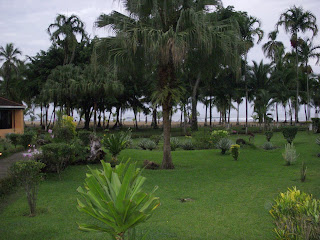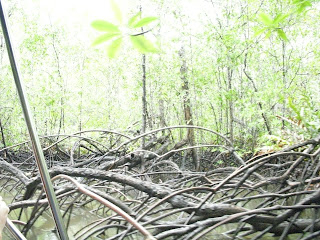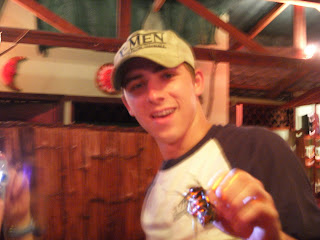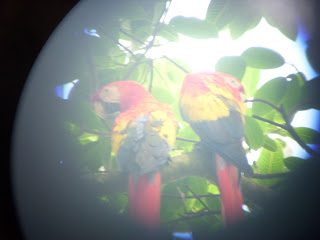Thursday, June 12, 2008
Updates....
Ecotourism: Poas Volcano and La Paz Waterfall Gardens
After leaving the volcano, we travelled to La Paz Waterfall Gardens just 30 minutes away. (La Paz means peace in Spanish for anyone who doesn't know.) This was definitely a huge form of ecotourism for the country, as it was place to view exotic species of birds, frogs, snakes, butterflies, hummingbirds, and plenty of other animals. We saw gorgeous toucans with rainbow colored beaks, small green macaws, and parrots that liked to climb on Peter's back. In the butterfly room we saw hundreds of different species of butterflies, including the well known blue morpho butterflies. Next was the humminbird are, which was so much fun because you got to be as close as you wanted to a bunch of hummingbirds flying past your face so quickly. As you can imagine, is was pretty difficult to get pictures because they move so fast! We also saw a number of different kinds of snakes, frogs, and monkeys. After viewing all of these wonderful animals, it is easy to see why Costa Rica wants to conserve its rainforests and protect its species diversity so badly. By letting tourists view these animals, they are hoping that we will feel the same way. How could you allow the destruction of all of these animals' habitats to continue after viewing them so closely and seeing how really magnificent they are? In this way, ecotourism in Costa Rica is helping to promote environmentalism, conservationism, and the protection of species diversity, as well as creating new jobs and stimulating the Costa Rican economy. As I have said before in past blogs, ecotourism is now the number one source of revenue in the Costa Rican economy. Thus, it seems as though ecotourism in Costa Rica is a win-win situation, for both people and the environment.
After the animal gardens, we walked down a bunch of stairs to view the waterfall, which was stunning and seemed to flow with extremely clean, clear water. Throughout our hike, we saw a number of waterfalls and took pleanty of pictures. (Unfortunately my camera battery died in the middle of the hike but I still have a few good ones.) At one of the locations, we got to see why they call one of the falls "white magic." The trick was to look at the rocks over which water was pouring for about 20 seconds, and then look to the right of the waterfall slowly. What we saw was some sort of optical illusion, as it looked like the rocks next to the waterfall were moving! It was really cool and I think I did it a few too many times because I was pretty dizzy for a while afterwards. The waterfalls really were a great sight to see, and once again they really made its visitors appreciate nature.
Ecotourism in Costa Rica is one of the new trends in economic development. It has brought much revenue and many jobs to the country, as well as benefitting and protecting the natural habitat. Hopefully other countries around the world will be able to follow Costa Rica's lead in this great industry. They too can protect their own environments and bring in tourists to view what makes their country beautiful. If this is done sooner than later, maybe the world can save hundreds of species from extinction and preserve the natural beauty that the earth has given us for free, which we so often take for granted.
Wednesday, June 11, 2008
Coffee
Tuesday, June 10, 2008
Bananas

Puerto Viejo, Cahuita, and Manzanilla

After leaving the Chiquita banana plantation, we headed off on our huge tour bus once again for Puerto Viejo, a small town on the southern Caribbean cost of Costa Rica. Puerto Viejo is basically a small version of Jamaica, and you can't walk more than 20 yards without seeing someone with dreadlocks. We got to the hotel, which seemed a little shady at first: it was in an alley and we were warned that Puerto Viejo is relatively not the safest town, just like San Jose. But, it actually turned out to be be pretty nice. The rooms were a decent size and had no bugs in them, which was great because our last hotel at La Selva was full of many of the insects that we saw in the rainforest. We settled in and went to dinner at a small shack at the end of town. We got the option of chicken or beef (standard here in Costa Rica), so I ordered the beef with a Carribean style sauce, which I never would have tried had I not been in the Caribbean. In between ordering and actually getting our meals, a few of us walked to some of the little shops along the beach. Ever vendor had basically the same stuff: lots of jewlery, bracelets, Bob Marley gear, and other fun things. All of us were offered pot at least twice, and a few of the guys were even offered cocaine. It was pretty funny, and we knew that it was a totally normal thing here. Now that I think about it, I don't think we saw a cop in that town the whole time we were there. Anyway, I bought a really cute bracelet that I wear almost every day. After shopping for about 20 minutes, we had to run back to dinner because it started to downpour. We got back to our table just in time for the food to be served. Our meals came with rice and beans, plantanes that tasted like cookies, and veggies. It was delicious and the service was great despite there only being two cooks. Then we all had one of the most delicious chocoalte cakes ever! It has been a while since I've had some good chocolate, because many of the desserts that we get here are fruity or at least somewhat healthy.
That night we went to one of the small bars on the beach, and it turned out to be a kareoke bar!! We all had a blast singing to the most random songs, including One Hand in My Pocket by Alanis, and even a few Spanish songs. You will all be shocked when I say this, but I was up at the mike singing most of the songs haha. Of course iIwas singing with 4 other people at all times, because we all know I could never sing anything solo: my voice is horrendous. We discovered that our amazing bus driver Ronaldo has a great singing voice, and he sang a few English songs with us which was so fun. After about an hour, we noticed that we had a crowd of locals watching us through the windows. I'm sure we looked like crazy drunk Americans, which I'm sure didn't surprose them. I had sooo much fun! But, the night doesn't stop there. We walked from the first bar to a second, which was much bigger, on the ocean, and an intense dance club. We danced all night, and hung out at the tables on the beach. We definitely felt like we were in paradise once again. Late into the night, a laungere show started, which I guess is becoming pretty popular here in Costa Rica. It was hilarious to watch.



All of us laying out at the beach after snorkeling.
After snorkeling, we drove to our hotel in Manzanilla, called Las Palmas. We were all shocked when we got there to see a gorgeous resort with its own private beach, a pool, plenty of plam trees, and luxurious rooms, which we had yet to experience. We immediately changed back into our bathing suits and played frisbee in the water. After a few hours of hanging around on the beach, we got ready for the buffet-style dinner in the veranda. It was absolutely delicious, of course, and I had some of the best fish I've ever had, but I have no idea what it was! We were all stuffed so we decided to take a nap. After sleeping for a few hours, a bunch of us decided that it would be a great idea to stay up all night and watch the sun rise at 5:00 the next morning. it turned out to be one of the best nights I've had on this trip, which says a lot. We played cards for a while ( for everyone at Miami we plyed Asshole so it reminded me of all of you!), swam in the pool for hours, and hung out on the beach just talking and having fun until morning. Unfortunately, it was too cloudy that morning to see the sun actually come up, but it was definitely worth it. Despite not sleeping at all, Marty, Abby, peter, and I decided to go for a run at 7:00 that morning along one of the roads and on the beach. It was a picture perfect run: it was sunny and we all felt great afterwards. The next day was pretty eventful as well: I layed out on the beach and relaxed, hung out in the pool, and just enjoyed the sun for the whole day. That night, we partied at the tiny hotel bar, watched some super weird movies, and had a bonfire on the beach. The bonfire was perfect, and Peter is definitely the best person to have if you are lost in a forest. He made a great bonfire out of wood he gathered from along the beach and in the forest. We all had fun talking and laughing at our instructor Glenn who was pretty drunk and told us he wouldn't remember any of this in the morning. A few of us then went for a night swim in the pool for about an hour, and this again was a great time. Overall, these 3 days were absolutely amazing, and I will never forget any of it or any of the amazing people that I spent it with!

Our hotel!

The small crab in our bath tub.


Abby and I's view from our room.

The 7 of us that stayed up all night! : Heidi, Bob, Me, Steve, Diane, PJ, and Evan.

PJ, Daine, Steve, and Heidi.

The start of it getting light out.. probably at 4:30 that morning.

The sunrise in the morning. Too bad it was cloudy.

The beach... absolutely paradise!
Coffee

Caribbean (hot) 8 servings
1 coconut
2 cups milk
4 cups strong coffee
1 tablespoon sugar
1. Punch two holes in to coconut, pour liquid into saucepan
2. Bake coconut for 30 minutes at 300 F degrees
3. Break open coconut, remove meat, and grate.
4. Mix coconut meat, coconut liquid, and milk in a sauce pan
5. Heat over low heat until creamy.
6. Strain
7. Toast grated coconut under broiler
8. Mix milk mixture, coffee, and sugar
9. Pour into mugs, garnish with toasted coconut.
Coffee Float (cold) 4 servings
2 1/2 cups strong coffee
2 teaspoons sugar
2/3 cup cream
4 scoops of coffee flavored ice cream
1 large bottle of Coke
1. Sweeten coffee with sugar, and chill
2. Mix coffee and cream
3. Fill 4 glasses half full
4. Add one scoop of ice cream to each glass
5. Top with coke
More recipes at: http://www.costarricancoffee.com/recipes.htm
Monday, June 9, 2008
Chiquita Bananas

On Saturday we visited the Chiquita banana plantation in Sarapiqui. We got to talk to and ask questions of two of their representatives and tour guides. Chiquita is an inorganic banana producer that has considered switching to organic production, but this would severely decrease the amount of bananas that they could produce and they would not be able to meet the overseas demand. Thus, they still use pesticides, herbicides, and insecticides on the banana plants, which can all have extremely damaging effects on workers and nearby residents, including exposure to carcinogens and toxins. When we drove up, we could see the signs next to the banana fields with skulls and crossbones telling workers not to enter the fields within 24 hours of the pesticide sprayings. However, the workers houses were no more than 10 yards from the fields anyway, so they must be getting some harmful effects just living there. Despite these facts, Chiquita is actually one of the most safe and environmentally friendly banana producers in Costa Rica. All of their agrichemicals are approved by the EPA and the EU, and only minimal amounts of these toxins are used. Chiquita has recently joined the Rainforest Alliance and has started to work on a project in which they employ local residents to plant trees in hopes of replacing rainforest areas from the plantation to La Selva's forests which are about a 30 minute drive away. According to Chiquita, the company has planted at least one million trees in residential areas. Also, working conditions are superb compared to other plantations. Chiquita makes sure that their employess are paid at least 40-50% above the minimum wage. Workers are well trained and are required to use protective clothing and gear at all times. All of their farms in Latin America are certified by independent auditors to the Social Accountability 8000 standard which ensures no child labor, protection of employee health, 48 maximum weekly working hours, and no harsh treatment. Lastly, Chiquita is striving to be as sustainable as possible. All of the twine and plastic bags that are used in the fields are recycleable, and the water is monitored regularly so that traps prevent organic waste from polluting streams and rivers.




Ecotourism: La Selva Research Station

 While at La Selva, we wnt on 3 different hikes through the rainforest. The first one was in the afternoon on Thursday, and we saw a bunch of really exciting animals and plants. There were huge caterpillars on the ground, and tons of poison dart frogs all over the place. These tiny frogs are red with blue legs and are lethal if eaten. We also saw monkeys playing up in the canopy and toucans flying from tree to tree. That night a few of us went on a night hike looking for snakes because there are supposed to be thousands of snakes all over these forests. We didn't see any snakes, but we saw plenty of huge spiders and other insects. In the morning we went on our last hike, and we saw at least 10 different species of birds. We learned from our guide about many of the plants in the area, including one plant that sends some of its roots down from the middle of its stem.
While at La Selva, we wnt on 3 different hikes through the rainforest. The first one was in the afternoon on Thursday, and we saw a bunch of really exciting animals and plants. There were huge caterpillars on the ground, and tons of poison dart frogs all over the place. These tiny frogs are red with blue legs and are lethal if eaten. We also saw monkeys playing up in the canopy and toucans flying from tree to tree. That night a few of us went on a night hike looking for snakes because there are supposed to be thousands of snakes all over these forests. We didn't see any snakes, but we saw plenty of huge spiders and other insects. In the morning we went on our last hike, and we saw at least 10 different species of birds. We learned from our guide about many of the plants in the area, including one plant that sends some of its roots down from the middle of its stem. 


Thursday, June 5, 2008
The Osa Peninsula
 On Sunday we travelled all day (for about 8 or 9 hours on a cramped tour bus) to get to the Osa Peninsula which is in the southern part of the country. The trip was pretty eventful, as the highways to get there are roads made of rocks and dirt. If the roads were actually paved all the way there, it probably would have cut our travel time in half. But, it was still nice to be able to enjoy the scenery going through extremely small towns. After about 5 hours of driving, we ran into some trouble: one of the bridges was out! We had no idea what was going to happen because we were in the middle of absolutely nowhere. After asking a few of the townspeople, we turned around and found a different road to get to our destination. But this had some problems too. One of the bridges that we had to go over was pretty shaky and thin. We all had to get out of the bus so that the bridge wouldn't collapse underneath us, and the driver had to take 30 minutes to maneuver the bus down the steep slope before the bridge and come out on the other side. We had to recruit a bunch of the townspeople to help out, and eventually all of the guys got behind the bus and pushed so that the back end didn't hit the ground. If the bus had been 6 inches longer, we definitely would not have made it! After that ordeal, we had to travel on a dirt road through a field of palm tress that stretched on for miles. After another hour, we finally reached a paved road and took that to a town on a river that continued on to the ocean. We all boarded some large motorboats and sped off to the river delta and into the ocean. The views were gorgeous throughout the whole ride, which took about two hours. We ended up in a remote little town and had to wade from the boats in the water onto the beach where jeeps were waiting to take us up into the hills to our "hotel." The place we stayed was unlike anywhere I have ever been! Our rooms were platforms with tents on top of them that looked out over the ocean. It was like camping, except we had a working toilet and shower (with no hot water of course) and actual beds with headboards and everything. The main building was a gorgeous open room with wood floors and couches. This is where we ate breakfast and dinner, and hung out all day when we had nothing to do. We had to take our shoes off when we walked in because everything outside was so muddy, which was fun because its not very often that I walk around nice places barefoot. The first night we hung out in the main lodge and played cards. We saw plenty of huge bugs and even a frog hanging out by the stereo.
On Sunday we travelled all day (for about 8 or 9 hours on a cramped tour bus) to get to the Osa Peninsula which is in the southern part of the country. The trip was pretty eventful, as the highways to get there are roads made of rocks and dirt. If the roads were actually paved all the way there, it probably would have cut our travel time in half. But, it was still nice to be able to enjoy the scenery going through extremely small towns. After about 5 hours of driving, we ran into some trouble: one of the bridges was out! We had no idea what was going to happen because we were in the middle of absolutely nowhere. After asking a few of the townspeople, we turned around and found a different road to get to our destination. But this had some problems too. One of the bridges that we had to go over was pretty shaky and thin. We all had to get out of the bus so that the bridge wouldn't collapse underneath us, and the driver had to take 30 minutes to maneuver the bus down the steep slope before the bridge and come out on the other side. We had to recruit a bunch of the townspeople to help out, and eventually all of the guys got behind the bus and pushed so that the back end didn't hit the ground. If the bus had been 6 inches longer, we definitely would not have made it! After that ordeal, we had to travel on a dirt road through a field of palm tress that stretched on for miles. After another hour, we finally reached a paved road and took that to a town on a river that continued on to the ocean. We all boarded some large motorboats and sped off to the river delta and into the ocean. The views were gorgeous throughout the whole ride, which took about two hours. We ended up in a remote little town and had to wade from the boats in the water onto the beach where jeeps were waiting to take us up into the hills to our "hotel." The place we stayed was unlike anywhere I have ever been! Our rooms were platforms with tents on top of them that looked out over the ocean. It was like camping, except we had a working toilet and shower (with no hot water of course) and actual beds with headboards and everything. The main building was a gorgeous open room with wood floors and couches. This is where we ate breakfast and dinner, and hung out all day when we had nothing to do. We had to take our shoes off when we walked in because everything outside was so muddy, which was fun because its not very often that I walk around nice places barefoot. The first night we hung out in the main lodge and played cards. We saw plenty of huge bugs and even a frog hanging out by the stereo.

The beach we ended up at.












Ecotourism in Costa Rica
